The border between Lebanon and Israel is perennially tense. Israel has invaded Lebanon at least three times and it occupied much of Lebanon’s south for eighteen years, until forced out by resistance fighters in 2000. Retaliatory missiles have flown from across the border into northern Israel on several occasions, especially during the 2006 war.
But there is generally little in-depth reporting on the ground from the Lebanese side. On a recent visit, I had the chance to travel widely in Lebanon and get a first-hand picture of the Shi’a community which constitutes the core of resistance to Israel and is committed to the Palestinian cause.
This was thanks mostly to a Lebanese friend — call him “Rami” — who works when he can as a tourist guide. Business has not been booming lately in the face of Lebanon’s seemingly permanent political crisis and a shattered economy exacerbated by the giant Beirut port explosion in 2020 and the collapse of the country’s Ponzi-scheme banking system. Few foreign tourists are coming to Lebanon these days. The US State Department even sternly warns Americans not to visit the country.
Rami is handsome and fit, a well-dressed and clean-shaven 40ish-year-old man. He speaks polite and fluent English, but when he drives his car through Beirut’s still chaotic traffic he swears loudly and vehemently in colorful Arabic.
Though he now lives in south-central Lebanon, inland from coastal Saida (Ancient Sidon), Rami often spends time with relatives in Beirut when he is working. His family is originally from further south, near the border with Israel, before they were forced to flee the war and Israeli occupation after 1982. From his work and his personal history, he knows Lebanon from one end of the small country to another.
Rami is also a devout Shi’a Muslim and a fervent supporter of Hezbollah. He says he is confident that he will pray at Jerusalem’s al-Aqsa sooner rather than later.
Hezbollah, literally “The Party of God,” is based in Lebanon’s Shi’a Muslim community. The Shi’a, historically impoverished and marginalized, are now believed to make up at least a plurality in Lebanon, whose political system is organized on religious/ethnic populations, rather than one-person-one-vote citizenship. The ethno-confessional balance in Lebanon is so fraught that there has not been an official census since 1932. Therefore, political representation is skewed in favor of the country’s shrinking Christian population.
Hezbollah is led by Sayyid Hasan Nasrullah, a revered religious figure, but it is also a political party with its own powerful militia, thought to be much more potent than the official Lebanese army. It describes itself as “The Islamic Resistance in Lebanon.” In parliament, Hezbollah is allied, sometimes uneasily, with Amal, another movement based in the Shi’a community, and with the predominantly Christian Maronite Free Patriotic Movement. FPM’s leader, former military man Michel Aoun, is the outgoing president of Lebanon. Today, Lebanon finds itself broadly divided between two political blocs. One is aligned with Hezbollah and its allies; the other is based in the rightwing Maronite Christian community, historically supported by Israel, and the Saudi-backed Sunni Muslim “Future Movement.” No official governing structure has taken office since national elections last May, which did not decisively change the political balance.
I remember reading somewhere a description of Lebanon’s Shi’a – and especially those who support the Resistance organization Hezbollah – as having one foot in heaven, one foot in resistance. A visit to Baalbek in the Shi’a-majority Beqaa Valley in the eastern part of the country provided a vivid illustration of this duality.
Near the entrance to Baalbek, we stopped at the shrine of Sayyida Khawla, revered by locals as a daughter of Hussein, the grandson of the Prophet Mohammed. Though Khawla is little attested historically, locals believe that after Hussein and his companions were martyred at the Battle of Karbala (680CE/61AH) in Iraq, she died as an infant in Baalbek when the surviving female prisoners were being taken back to Damascus, capital of the victorious Caliph Yazid.
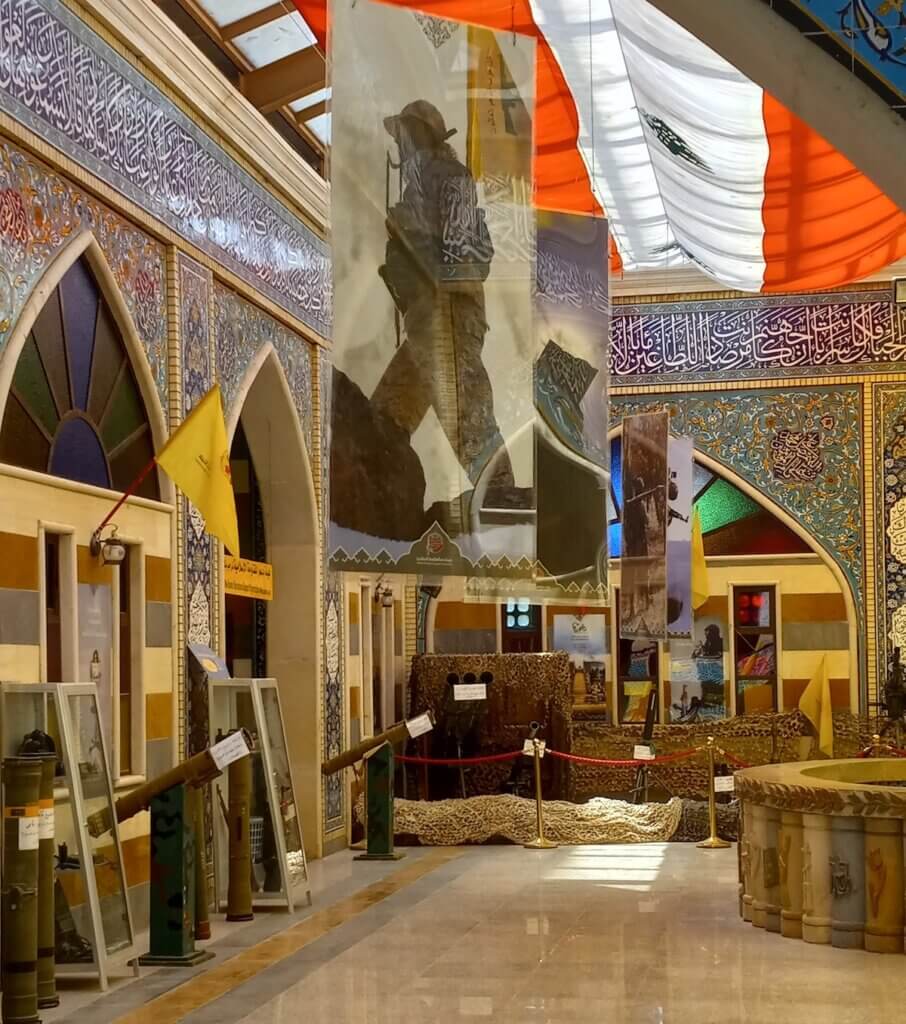
Khawla’s shrine and mosque, rebuilt and enlarged with Iranian funds in the 1990s, is adorned outside with beautiful decorative tiles and inside with ornate multi-colored carvings, gilt and crystal chandeliers in the ornate taste of Shi’a holy sites. Worshipers, including our friend Rami, prayed emotionally before Khawla’s tomb inside the shrine when we visited.
But adjoining Khawla’s shrine is another building in the same complex, an extensive museum dedicated to Hezbollah’s military victories and its ongoing resistance against Israel. A succession of exhibition rooms shows Hezbollah weaponry, photos of religious and military leaders and posters documenting the organization’s military prowess. Above was stretched a banner reading in Arabic and English: “The Islamic Resistance Support Organization Welcomes You.” Diorama models portray episodes in the fighting, such as the siege of the Israeli-occupied Crusader fortress of Beaufort and the successful missile attack against an Israeli warship off Beirut.
![Topographic representation of the Lebanese border with Israel — labeled “Palestine” — with a large arrow pointing south labelled “the Way to al-Quds [Jerusalem]," at the Hezbollah museum in Baalbek, Lebanon. (Photo: Jeff Klein)](https://mondoweiss.net/wp-content/uploads/2022/10/20220618_142225-1024x562.jpg)
The connection between Hezbollah and the Palestinian liberation struggle was emphasized throughout. There was a model of the prison of Khiyam where suspected Palestinian and Hezbollah fighters were held and tortured by the Israelis, an imagined view of a future liberated al-Aqsa compound and a topographic representation of the Lebanese border with Israel — labeled “Palestine” — with a large arrow pointing south labelled “the Way to al-Quds [Jerusalem].”
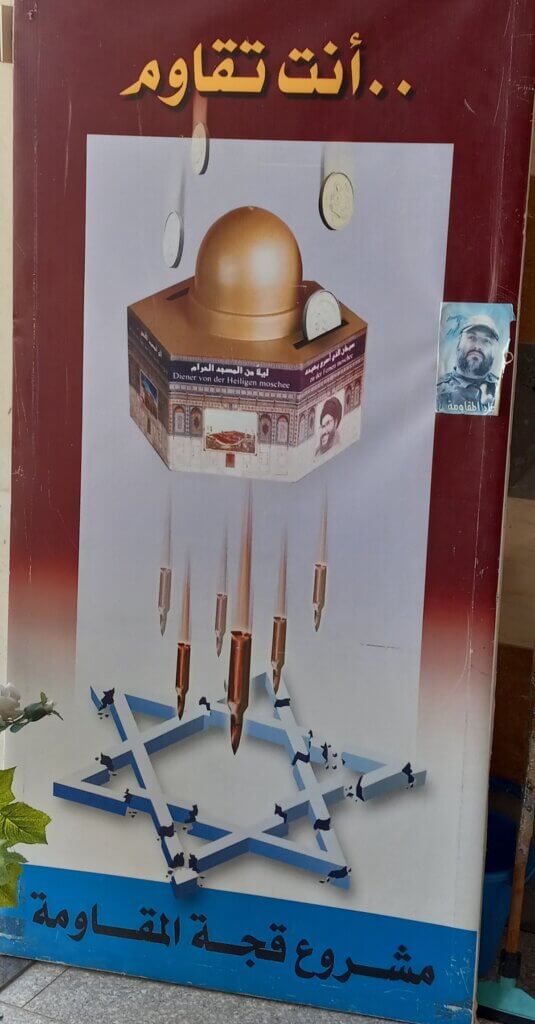
A poster urged contributions to the resistance picturing a donation box shaped like Jerusalem’s Dome of the Rock and showing money converted into bullets aimed at the national symbol of Israel. A photo of Imad Mughniyah, the Hezbollah leader assassinated by Israel, is affixed to the side.
One of the photo exhibits featured a surprising montage of Gamel Abdul Nasser, Syria’s Hafiz al-Assad and the famed Libyan resistor against Italian colonialism Omar al-Mukhṭār, known as “The Lion of the Sahara,” who was captured and executed by the occupiers in 1931 – alongside of portraits of Fidel Castro and Che Guevara.
Not far from Baalbek, we visited an agricultural village I have known for years which is decidedly rooted on this earth. The Beqaa Valley is Lebanon’s breadbasket. We crossed fields of newly-harvested winter wheat, vegetables gardens, fruit orchards, vineyards – and numerous lots planted with hashish (marijuana). Arriving at a friend’s house, I was welcomed as usual with a polite hash cigarette.
Marijuana is nominally illegal in Lebanon, but it is grown quite openly in the Beqaa Valley and elsewhere. I asked my friend whether they had to pay bribes to government officials to look the other way and his response was “We are stronger than the government.” Whether he meant the powerful clan based in the village or Hezbollah itself, it seemed hard to argue. Under pressure from visiting representatives of the US Drug Enforcement Administration (DEA), the Lebanese government sometimes makes a show of publicly burning a hashish field now and then, but that is it.
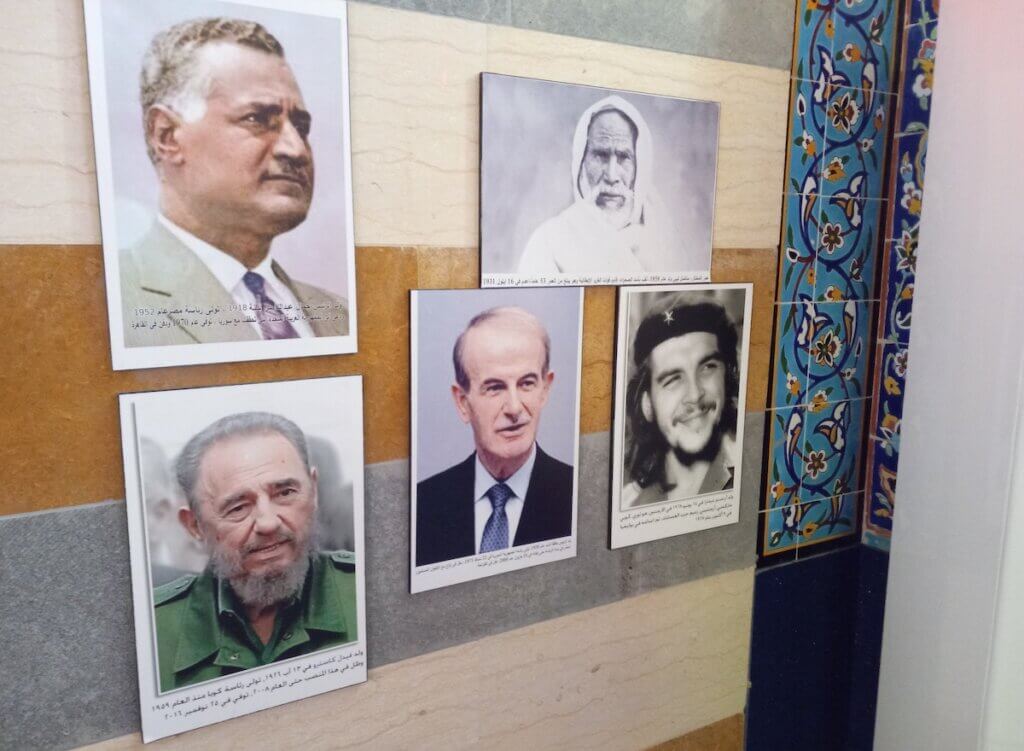
The villagers are Shi’a, claiming Kurdish ancestry and a military tradition going back to Salaheddin al-Ayubi, the conqueror of Crusader Jerusalem. They are decidedly relaxed in terms of strict religious observance. Many women are active in public without hair covering and alcoholic arak consumption is not uncommon in the village.
Aside from agriculture and hash production, many of the villagers also serve as part-time or professional Hezbollah fighters. Up to 500 men from the village are said to have served in Syria. Some of them had gone for advanced military training in Russia. An old acquaintance, who was recovering from serious wounds at the battle of Qusayr in Syria when I visited in 2013, was away this time for field training at a nearby militant camp. “Abu ‘Ali” — a familiar title common to many men in the village where first sons are often named after the revered founding imam of Shi’a Islam — was considered a Hezbollah missile expert.
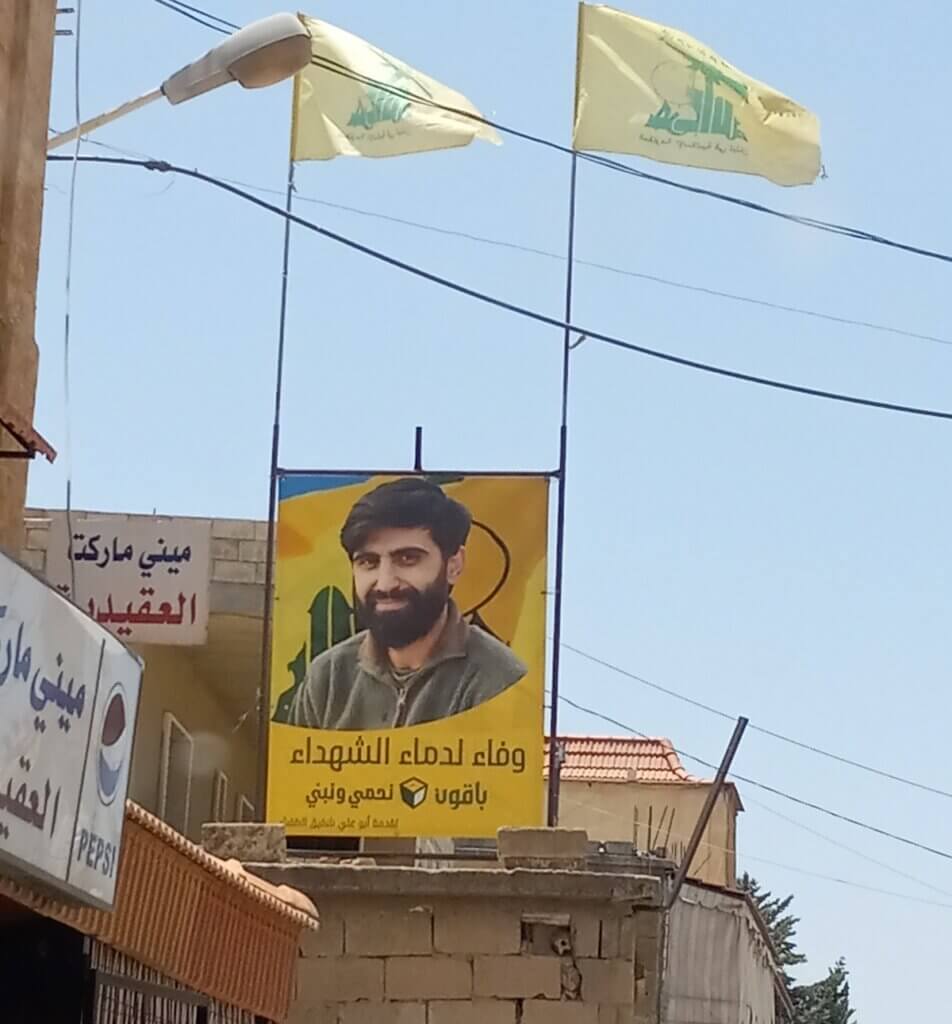
This military involvement with Hezbollah has not been without cost. Martyr flags and banners dot the roads and villages in the Beqaa Valley.
In south Beirut, we visited indoor Hezbollah cemeteries at locations known as “the Garden of the Two Martyrs” where scores of resistance leaders and rank-and-file militants are buried. There is found the tomb of Mughniyah Hezbollah commander, assassinated in 2008 by a car bomb in Damascus is there and also his eldest son Jihad killed in an Israeli air strike in Syria’s Golan in 2015; Samir Kuntar, a Lebanese Druze militant destroyed with other Hezbollah commanders in a 2015 Israeli missile attack; Hadi Nasrallah, the son of the Hezbollah leader was killed in 1997. Many others fallen in combat or targeted by Israeli terror attacks over the years are also buried there.
Lebanon’s Shi’a, like other Muslims but even more so, both mourn and celebrate those who have fallen in the resistance struggle. Sayyid Hasan Nasrallah is supposed to have commented: “I am proud to be the father of one of the martyrs.”
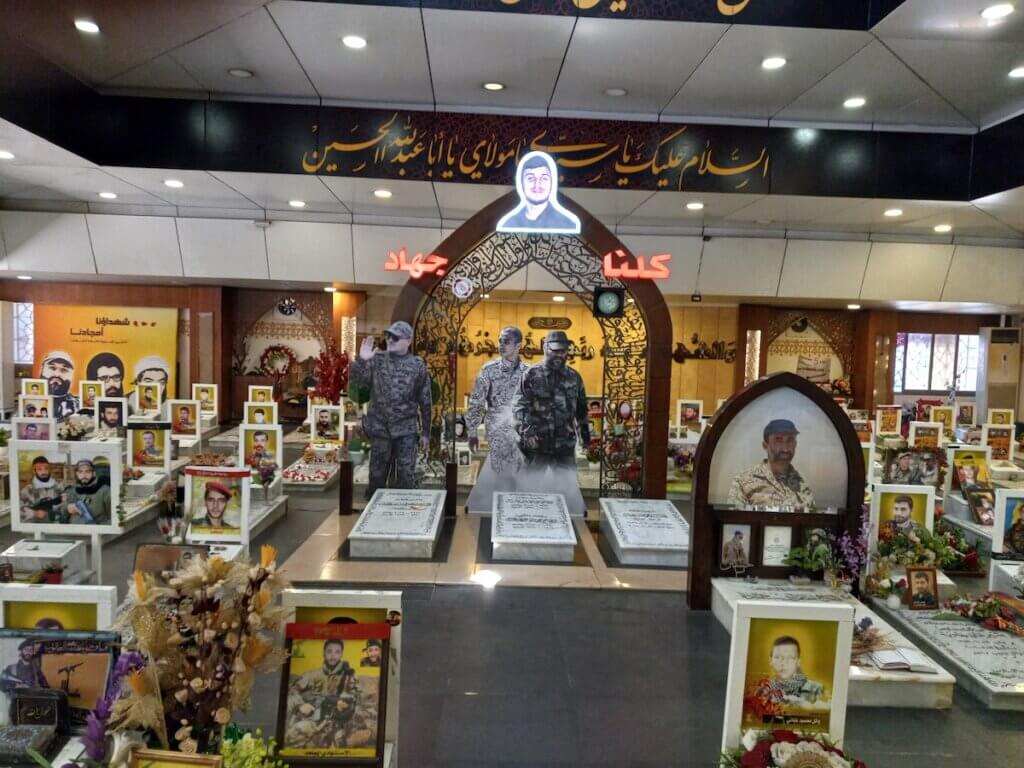
Returning to Beirut after visiting the Beqaa Valley, we had the chance the next day to visit Lebanon’s southern border with Israel. Because this area is effectively still a war zone and is nominally patrolled since 2006 by international peacekeepers under UNIFIL (“United Nations Interim Force in Lebanon”) non-local residents need special authorization from Lebanese security services to travel there. We managed to obtain the necessary permits in Saida on the way south.
Before reaching the closed border area, we stopped at the mountaintop site of Mleeta, not far from the city of Nabatiyeh. Mleeta is a cross between extensive monument to Hezbollah’s military victories over Israel and a theme park visited by Lebanese families and school groups. Exhibits show representations of battles in Lebanon’s south, reenactment displays, Hezbollah military hardware, and destroyed Israeli tanks together with explanatory texts. There is also an indoor museum and – of course! – a gift shop.
Rami had called ahead to arrange for us to interview some of the Hezbollah staff who manage the site. We met with a couple of officials in a reception room at Mleeta’s administration building, who after some vetting questions and Rami’s personally vouching for us, introduced Mohammed, a part-time volunteer guide who spoke good English.
Mohammed was a bit reticent at first as it was unusual to meet Americans at this place. After some polite back-and-forth questions, we explained that we were friends of Lebanon and Palestine, interested to hear the perspective of Hezbollah. We reassured Mohammed that we were not just tourists but American activists and leftists. He responded with a raised eyebrow and mock surprise: “There is a left in the US?” We all had a laugh at that and then Mohammed proceeded to tell his story.
Mohammed was born in 1974 in the village of Arab Selim, not far from Mleeta. He says he spent his entire youth under Israeli bombing or direct Israeli occupation after 1982. When he was a child, his family left to spend a year in Kuwait where his grandparents were working. After they returned to Lebanon, which was then under near constant Israeli bombardment, they fled from Arab Salim “like the Palestinian refugees,” to the town of Maghdousheh near Saida. His family was able to return to their home only in the 1990s, thanks, he says, to Hezbollah’s successful resistance against the Israeli military occupation. “Before that, they could kill us every day.” He adds: “You can’t be a human being in South Lebanon and not support Hezbollah.”
Mohammed says he first met Hezbollah fighters after his family returned to Arab Salim. “They were so kind and humble, willing always to sacrifice themselves. I recognized that we were back in our home only because of Hezbollah.”
Before that, Mohammed and his family were not particularly religious. Both his parents were teachers and he began his education at a school in Nabatiyeh run by Maronite nuns. Nearly all the students were Shi’a Muslims and many of the Christian teachers were pro-Israel at first, and very racist against Palestinian refugees. The nuns pressured the girls to remove their hijabs, but none of them complied.
Later, under the effects of Israeli occupation and the atrocities committed by Israeli soldiers, most of the South Lebanon Maronites began to change their views. Today, Mohammed says, most local Christians are also against Israel and support the alliance of Lebanese President Michel Aoun’s Patriotic Union Party with Hezbollah. He cites the example of the popular singer Julia Boutros who performs to packed and cheering mostly Christian audiences her iconic song Ahebba’i (“My Beloveds”), the lyrics from an address by Hezbollah’s leader Hasan Nasrallah.
Mohammed got emotional when remembering his own family’s experience under Israeli occupation. When he was four years old Israeli soldiers invaded his village, arrested all the men including his father and held them for a week. Forty houses were demolished by the occupiers. In 1985 his uncle – the only son among five sisters – was martyred while trying to escape from Israeli custody at the age of 24. In 1998 Mohammed’s closest childhood friend was killed. “I lost half my life then,” he says, and he still mourns him with flowers at the river where they used to play.
All told, Mohammed lost 24 friends to the Israelis or in Syria. He says, choking up, that the saddest time of his life was in 1996 when a crowd of Lebanese civilians who were seeking refuge at a UN base in Qana, not far from the southern border, were shelled by the Israeli army. More than one hundred were killed and an equal number wounded. (Qana is believed by many to be the site of the gospel miracle of the loaves and fishes.)
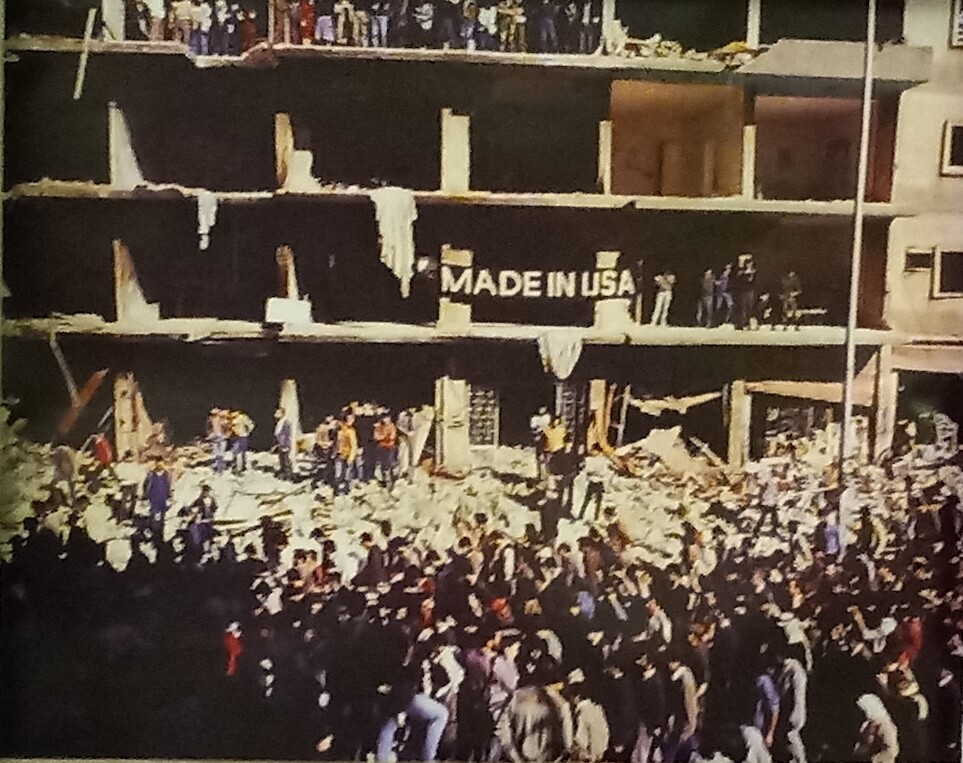
In 1991 Mohammed began to attend university in Beirut. As a student he lived in the Hezbollah-dominated neighborhood of Dahiya, where, he says “even the trees there are resistance.” This is still true. A café I visited in Dahiya displayed a large mural of a Gaza fighter and numerous photos depicting Israeli bombing of the neighborhood with US-supplied weaponry. One showed a crowd gathering in front of a ruined building labeled “Made in USA.”
Another showed people marching under the banner “DEATH TO AMERICA… DEATH TO ISRAEL.”
While he was away in Beirut, the Israelis attacked Mohammed’s home village again and smashed it completely. He became active at university with Hezbollah and received military training, first in Beirut and then at a camp in the Beqaa Valley where he was instructed in artillery. In 1998 he participated in fighting near Mleeta as a mortar operator. After graduating from university in 1997 and later serving a year in the Lebanese army, he returned to be a teacher in his village and a volunteer with Hezbollah.
Mohammed wanted us to understand that resistance is not “terrorism” but “a movement to liberate our country — like the resistance in Europe during World War II.”
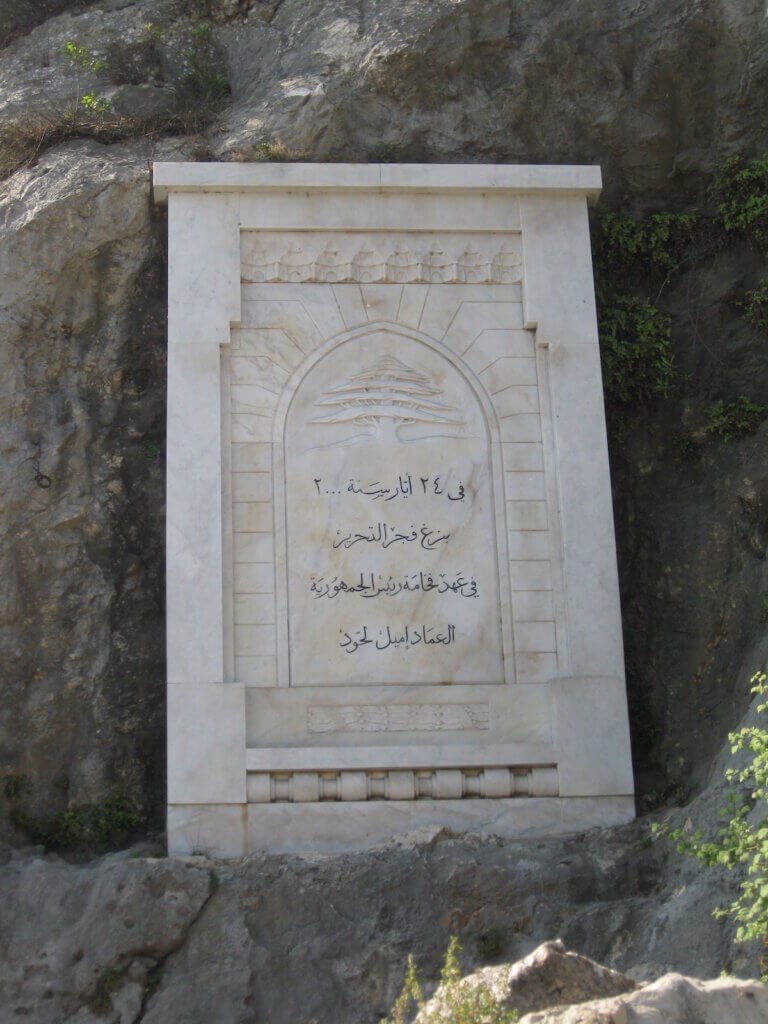
The year 2000 was a highpoint for Mohammed. Under pressure from Hezbollah, the Israeli army completely withdrew from South Lebanon, blowing up their own positions as they left. “We couldn’t believe the release from occupation. For 15 years we could barely leave our village. For the first time we could come and go with no fear.” The Israeli retreat is celebrated by a monumental inscription at the historic site of Nahr al-Kalb, just north of Beirut.
After the interview at Mleeta, we headed south past UNIFIL checkpoints into the security zone along the border. The road runs through the Lebanese highlands overlooking the Israeli-held Hula Valley and the cities of Metula and Qiryat Shmona. The Israelis have built a concrete wall along the demarcation line, as in the Palestinian West Bank, and like that other wall this one is used as a canvas for resistance artists. Near Odaisse a mural depicts a hole blown in the wall and a vision of Jerusalem’s Al-Aqsa beyond, labeled in Arabic “Gate of Return.” Next to this is a cojoined face with a Lebanese resistance fighter on one side and a Palestinian on the other.
Further south we visited towns that became famous for fighting during the Israeli invasions of Lebanon, especially Bint Jbail, just a few miles inside Lebanon, which the Israelis failed to take in their 2006 war. We finished the long day nearby, in Maroun al-Ras, at the “Iran Park” recreation area with picnic tables, barbeque grills and various indoor facilities, which were frequented by Lebanese families. At the park’s southern edge, there were observation towers overlooking Israeli agricultural land far below. One of them was topped by a huge effigy of Qasem Soleimani, the commander of Iran’s Islamic Revolutionary Guards Corps Quds Force, who was assassinated by the Trump administration in 2020.
Soleimani’s figure has his arm outstretched pointing south, towards Jerusalem.
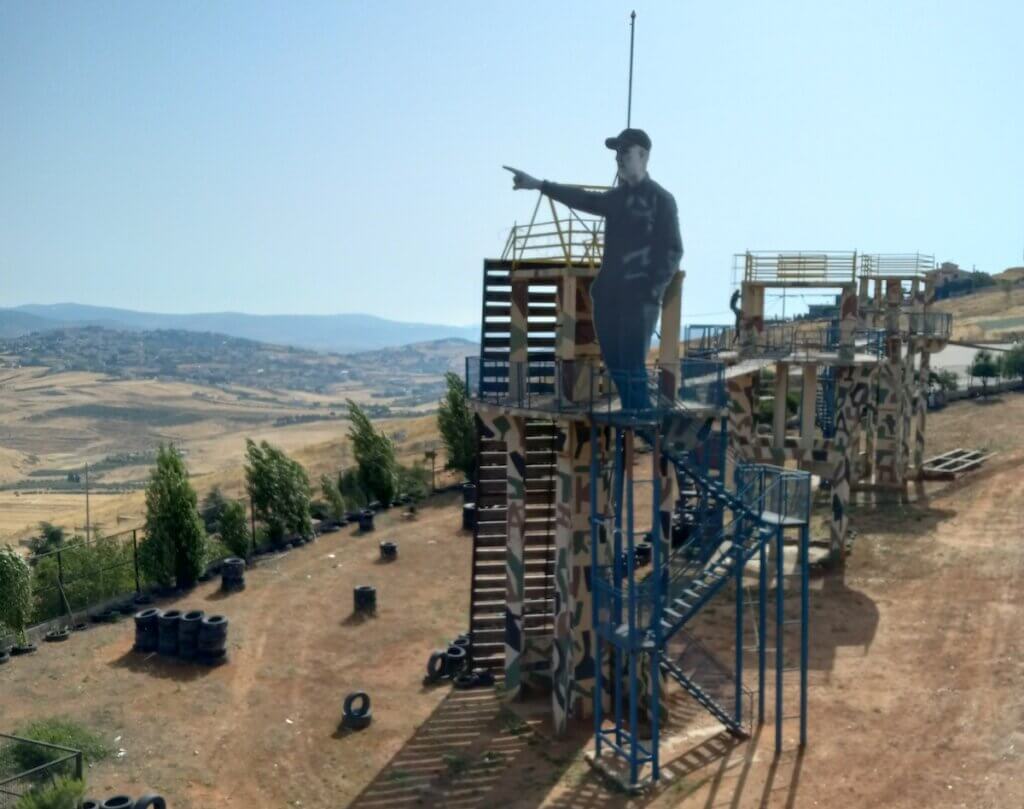
Jeff Klein
Jeff Klein, is a retired local union president, a long-time Palestine solidarity activist and a board member of Mass Peace Action.

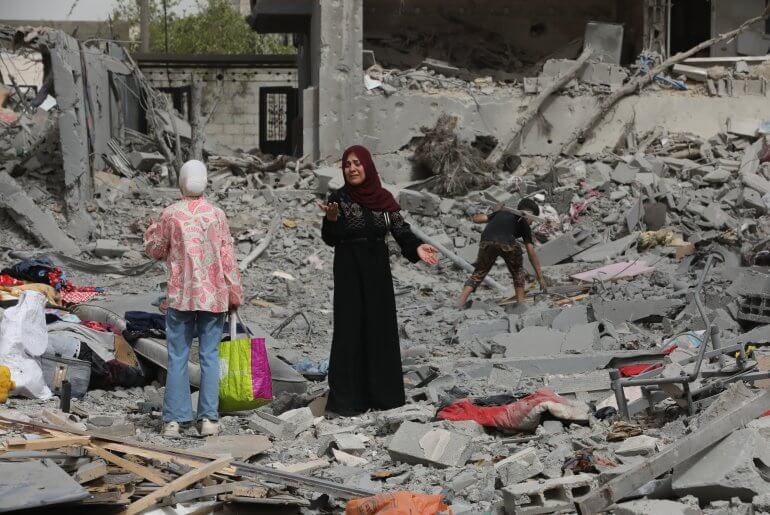

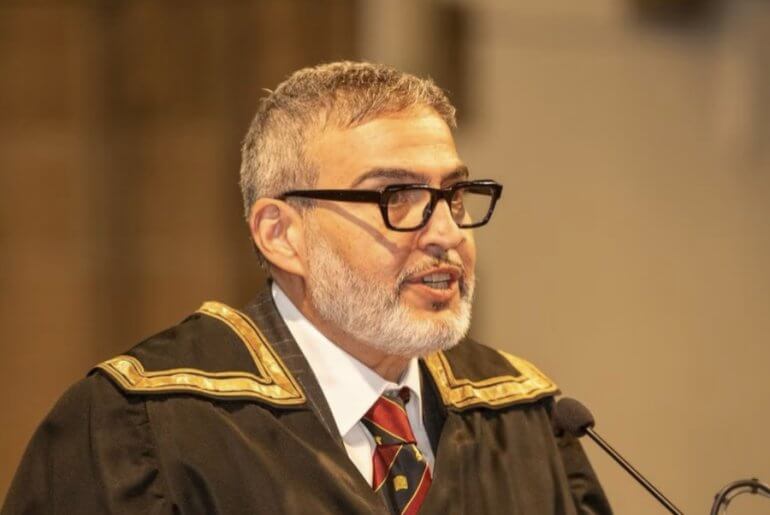
When you resist agression, oppression, occupation, you are a freedom fighter, whether you are Lebanese, Palestinian or 18th century American. What’s outrageous is committing these crimes.
Wonderful travel log covering the brave people of Hezbollah. I am impressed that Mr. Klein has captured the essence of the resistance. Since Iran and Hezbollah have taken Lebanon over, Lebanon, just like Iran, is doing so well. The women of Iran are being killed throughout Iran by the wonderful Revolutionary Guards and their allies, so it’s so nice to see how Mondoweiss stands with the people of Iran, at least with the ones with the guns who are shooting their own citizens. As I read this travel log, it occurred to me that Mondoweiss is either employing a bunch of fools who are pretending to be Jews, or this is a well-orcestared propaganda operation funded by the FSB. Mr. Klein, your article would have been perfect for Pravda. The blood of the people of Lebanon and Iran is on your conscious. As long as you can attack the Jews and the evil zionists, any co-hater is welcomed to the party, Hezbollah and Hamas included.
Shame on Mondoweiss for publishing, on the eve of Yom Kippur, an essay glorifying a clerical-fascist terrorist organization, with a genocidal agenda. Including an illustration looking forward to bombs falling on the Jews. Outrageous.